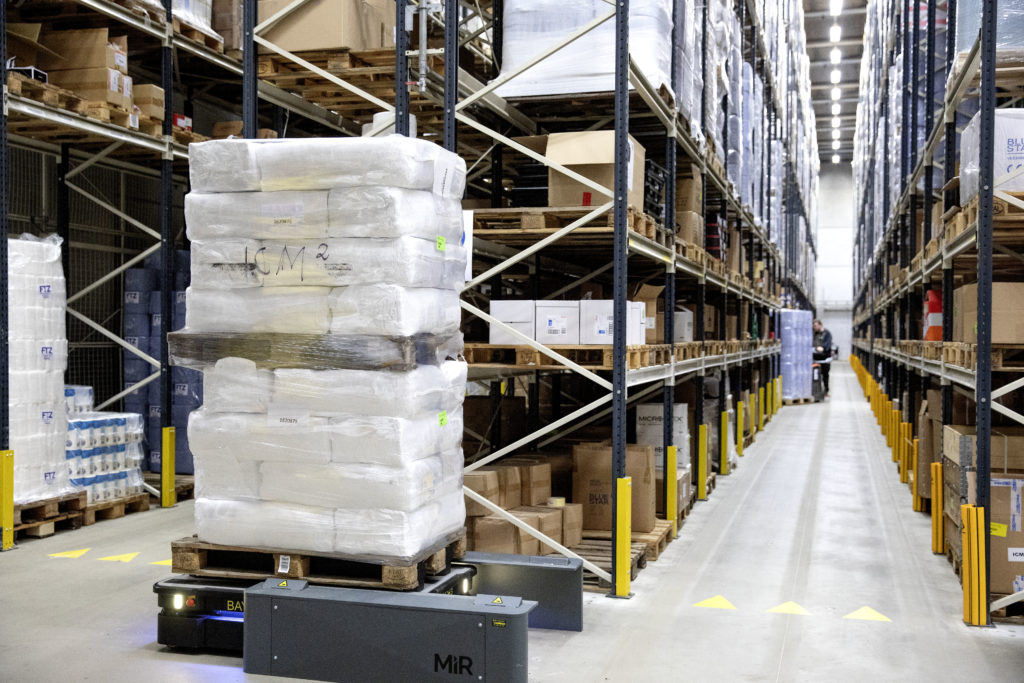While every warehouse or distribution center is different, they all need to efficiently and safely move materials to meet accelerating demand. Danish wholesale company ICM A/S has deployed mobile robots from Mobile Industrial Robots ApS to augment its human workers, who can now focus on higher-value activities.
ICM was founded in 1946 and is one of Scandinavia’s leading suppliers of technical equipment, work environment products, and personal protective gear. It has warned of shortages because of the COVID-19 pandemic.
Challenges at ICM
ICM runs pallet transport operations every day from 7:00 a.m. to 10:00 p.m., and it moves a total of 100,000 orders per year relatively long distances on 31,000 pallets. Most of its orders are for same-day delivery.
The internal logistics flow at the company’s high-rise warehouse in Odense, Denmark, mainly uses human-operated trucks in narrow aisles with 40-ft. high racks. Space is limited, so ICM must optimize its use of time, personnel, and space.
ICM has four human-driven, high-reach trucks, plus 10 manual stackers and 26 employees. Devising the optimal workflow for the entire flow of traffic and transport of goods in the logistics center has been a learning process, said Søren Jepsen, supply chain director at ICM.
“Our warehouse uses the chaotic storage principle, managed by a warehouse management system,” he explained. “We must be geared to be able to drop everything in order to be able to deliver within 24 hours to our customers in Denmark. This means it’s about using our resources shrewdly. We’re investing in new technology in order to safeguard our staff and to attract new, talented people.”

Solution
Fortunately for ICM, Odense is home to one of the most prominent robotics clusters in Europe, if not the world. One of its neighbors is Mobile Industrial Robots (MiR). ICM acquired heavy-duty MiR1000 robots, so named because of their ability to move 1,000kg (2,204.6 lb.).
“Thanks to an investment in three mobile MiR1000 robots, three employees now save several hours each on daily activities,” said says Jesper Lorenzen, a warehouse assistant who is responsible for goods reception at ICM. “They no longer have to spend time manually moving pallets from a stacker to the aisles in the high-rise warehouse.”
Instead, the workers can place the pallets on special MiR racks, from which the robots collect the pallets and transport them to the aisles inside the high-rise warehouse. The MiR robots leave the pallets at the end the aisles to be collected by high-reach trucks that place them in the relevant racks.
“The high-reach truck operators automatically report when they have taken a pallet from a rack, so I can just press a button on the tablet screen and send one more MiR robot on a mission,” Lorenzen said. “This way, the robots ensure the high-reach trucks are always supplied with pallets.”
Traffic needs coordination
The operators can use a map on tablets in their trucks to see where the mobile robots are at all times. In the busiest areas, the MiR1000s use audio signals and lights. This enables close collaboration between the trucks and the robots. In an environment with constant traffic, communication among vehicles is vital to avoid different machines blocking one another’s paths.
ICM has made a dedicated route for the mobile robots, freeing space for other traffic in the logistics center. Previously, space was very cramped because of the many operations with manual stackers on the main traffic routes, which have now been replaced by the MiR robots.
The MiR Fleet management software chooses the mobile robot that can carry out a task in the shortest time. It also ensures that the three mobile robots automatically move to a charging station between tasks to minimize downtime.

Mobile robots provide results for ICM
MiR’s mobile robots have saved about 40 hours a week at ICM, time that the staff previously spent on moving goods between the receiving and positioning areas.
These employees can now focus on higher-value activities, such as planning and optimization. Assessing, handling, and prioritizing the pallets and their contents is a complicated task that requires insight and experience because many parameters must be taken into consideration. Therefore, people are best for performing such tasks.
“The robots have saved time, which we can now use to optimize the warehouse and fine-tune flow,” said Lorenzen. “We have become used to the new technology and have learned to work in a completely different way. The more we apply it, the more time we save through automation using mobile robots.”

Mobile robots improve morale
Not only have MiR’s mobile robots increased efficiency, but they have also improved the working environment, according to Brian Brandt, warehouse manager at ICM. Job satisfaction is important in warehouses, where recruitment and retention are often challenging.
“It’s just so much fun working with mobile robots. Being able to move something from A to B without even touching it, that’s really cool,” he said. “The design of the MiR robots is so simple and user-friendly that I could take a new colleague in from off the street, and they would also think they’re logical to use.” He smiled as he observed a MiR1000 robot moving past, carrying a 600kg (1,322-lb.) load of cleaning cloths on a pallet.
While mobile robots currently aid the flow of goods from the receiving area to the storage aisles, ICM’s management sees the potential in automating more supply chain processes. In the long term, it could benefit from the use of robots for picking to the delivery of goods.


Leave a Reply
You must be logged in to post a comment.